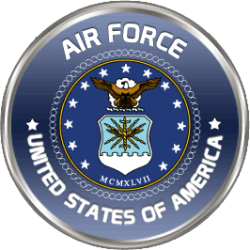Alfred August Kessler, Jr.
Major General, U.S. Air Force
Alfred August Kessler, Jr. was born on 3 August 1898 in Union Hill, NJ.
During World War I, Kessler attended Officers' Training Camp at Plattsburgh, NY, and was appointed a Second Lieutenant of Infantry on 16 September 1918. He resigned this commission on 14 November 1918, to enter the U.S. Military Academy. He graduated with a Bachelor of
Science degree and was commissioned as a Second Lieutenant in the U.S. Army Air Service on 13 June 1922.
His first assignment was to Brooks Field, TX, as a student at the Air Corps Primary Flying School from September 1922 to May 1923, when he graduated. He then graduated from the Air Corps Advanced Flying School at Kelly Field, TX, in January 1924, remaining thereafter at Kelly Field until July 1924, when he was ordered to Camp Nichols, Philippine Islands, for two years.
Upon his return to the U.S., he was ordered to Brooks Field until December 1927, and then was on duty for seven months at the San Antonio Air Depot, TX. He was next detailed to the Air Corps Engineering School at Wright Field, OH, and following graduation in 1929, remained at Wright Field as Pursuit Project Officer. In September 1931, he was assigned to the Massachusetts Institute of Technology at Cambridge, MA. He completed this course in June 1932 and was awarded a Master of Science degree in Aeronautical Engineering. He was then assigned as Commanding Officer of the 57th Service Squadron at Selfridge Field, MI.
In February 1934 he became Engineering Officer for Army mail operations at Candler Field, GA, and was transferred to Bolling Field in Washington, DC, on a similar assignment in March 1934. He then returned to Selfridge Field as Commanding Officer, 27th Pursuit Squadron. He was made Air Corps Supply Officer at Selfridge Field in March 1935 and assumed command of the 56th Service Squadron at that field the following September. In June 1936 he was transferred to Wright Field, OH, for duty with the Field Service Squadron.
He was Chief of the Procurement Section in the Office of the Chief of the Air Corps, Washington, DC, from December 1938 to July 1939, when he became Chief of the Contract Section of this office. In September 1939 he was detailed to the Air Corps Tactical School at Maxwell Field, AL, and following graduation in December 1939, he returned to Washington to resume his duties as Chief of the Contract Section, Materiel Command, Office of the Chief of Air Corps.
From August to October 1942 he was assigned to the 2nd Bomber Command, 2nd Air Force at Spokane, WA, and assisted in the implementation of the training program for heavy bomber groups and replacement crews.
In October 1942, he was assigned as Commanding Officer of the newly-activated 95th Bomb Group (Heavy) at Geiger Field, WA. After organizing and training the group at the air bases at Ephrata, WA, and Rapid City, SD, he departed with the group in April 1943 for England as a unit of the 8th Air Force famed for its daylight bombing raids on "Fortress Europe."
In August 1943 he was announced as Commanding Officer of the newly-activated 13th Combat Bomb Wing which participated in all actions of the 8th Air Force, including the first spectacular "shuttle bombing" from England to bomb Regensberg, Germany, and then on to North Africa, for which the unit was awarded its first Presidential Citation.
In February 1944, he was sent to Russia to negotiate, build, and operate the base in Russia to be utilized for the England to Russia "shuttle bombing" resulting from the agreement between President Roosevelt and Marshal Stalin at the Teheran Conference. As Commanding Officer and later, as Deputy Commanding General of these Russian bases (then designated as Eastern Command, U.S. Strategic Air Forces with headquarters at Poltava, Russia), he commanded the first friendly foreign troops to operate from Russian soil. Upon completion of this project in October 1944, he returned to his command of the 13th Combat Wing in England where he participated in the continued operations of the 8th Air Force in the strategic bombing of Germany and direct air support of our ground forces.
In December 1944, he became Military Air Attaché, Stockholm, Sweden. Upon return from Sweden in October 1947, he was appointed Director of Procurement and Industrial Planning in the Office of the Deputy Chief of Staff for Materiel at U.S. Air Force headquarters, Washington.
In March 1950, he became Deputy Director of Maintenance, Supply & Services, Deputy Chief of Staff/Maintenance and in April 1951 was named Director of Supply & Services. In September 1952, he assumed command of Fourth Air Force at Hamilton AFB, CA.
Medals and Awards
Silver Star Medal
Legion of Merit (2 Awards)
Distinguished Flying Cross
Air Medal (2 Awards)
Army Commendation Ribbon
Soviet Order of Sovorov
Commanders Cross of the Order of St. Olav with Star (Norway)
Croix de Guerre with Palms (Belgium)
Royal Order Croix Rouge (Sweden)
Royal Order of the Sword (Sweden)
Major General Kessler was also a Command Pilot, Combat Observer and Aircraft Observer.
Death and Burial
Major General Alfred August Kessler, Jr. died on 30 November 1956 in San Francisco, CA. He is buried at San Francisco National Cemetery in San Francisco.










